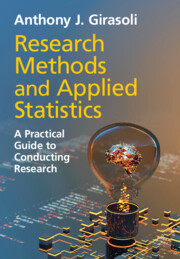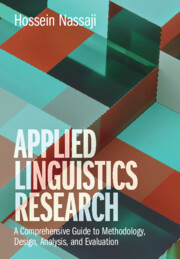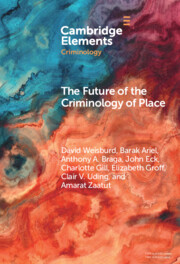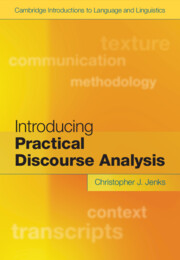Refine search
Actions for selected content:
131 results

Research Methods and Applied Statistics
- A Practical Guide to Conducting Research
- Coming soon
-
- Expected online publication date:
- October 2025
- Print publication:
- 02 October 2025
-
- Textbook
- Export citation
Chapter 9 - The Perception of Facial Expressions of Emotion
- from Section III - Emotion Perception and Elicitation
-
-
- Book:
- The Cambridge Handbook of Human Affective Neuroscience
- Published online:
- 16 September 2025
- Print publication:
- 02 October 2025, pp 185-206
-
- Chapter
- Export citation
Community engagement studios to improve racial diversity and health equity in Parkinson’s
-
- Journal:
- Journal of Clinical and Translational Science / Volume 9 / Issue 1 / 2025
- Published online by Cambridge University Press:
- 09 September 2025, e217
-
- Article
-
- You have access
- Open access
- HTML
- Export citation

Applying Corpus Linguistics to Illness and Healthcare
-
- Published online:
- 05 September 2025
- Print publication:
- 25 September 2025
-
- Book
-
- You have access
- Open access
- Export citation

Applied Linguistics Research
- A Comprehensive Guide to Methodology, Design, Analysis, and Evaluation
- Coming soon
-
- Expected online publication date:
- August 2025
- Print publication:
- 11 September 2025
-
- Textbook
- Export citation
The thematic series on the psychosocial and mental health impacts of terrorism and collective violence: narrative review of common themes from diverse events, places and research methods
-
- Journal:
- BJPsych Open / Volume 11 / Issue 5 / September 2025
- Published online by Cambridge University Press:
- 01 August 2025, e169
-
- Article
-
- You have access
- Open access
- HTML
- Export citation
A Bibliography on Judicial Independence in International Tribunals and Apex Courts
-
- Journal:
- International Journal of Legal Information / Volume 53 / Issue 2 / Summer 2025
- Published online by Cambridge University Press:
- 13 August 2025, pp. 115-133
- Print publication:
- Summer 2025
-
- Article
- Export citation
1 - Stratification Economics and Disability Justice
-
- Book:
- Stratification Economics and Disability Justice
- Published online:
- 21 June 2025
- Print publication:
- 05 June 2025, pp 25-51
-
- Chapter
- Export citation
Participatory democracy and participatory research
-
- Journal:
- European Political Science Review / Volume 17 / Issue 3 / August 2025
- Published online by Cambridge University Press:
- 14 May 2025, pp. 359-377
-
- Article
-
- You have access
- Open access
- HTML
- Export citation
12 - Bringing it together
- from Part 6 - Decision-making
-
- Book:
- Introduction to Epidemiology for the Health Sciences
- Published online:
- 28 May 2025
- Print publication:
- 24 April 2025, pp 348-379
-
- Chapter
- Export citation
1 - Thinking critically, problem-solving and setting priorities in epidemiology
- from Part 1 - Thinking like an epidemiologist
-
- Book:
- Introduction to Epidemiology for the Health Sciences
- Published online:
- 28 May 2025
- Print publication:
- 24 April 2025, pp 2-32
-
- Chapter
- Export citation
2 - Core Research Tools
- from Part I - Fundamentals
-
- Book:
- Rethinking Clinical Research
- Published online:
- 13 March 2025
- Print publication:
- 20 March 2025, pp 35-49
-
- Chapter
- Export citation
“Fieldwork” North Korea: Observations of daily life on the ground inside the country
-
- Journal:
- Asia-Pacific Journal / Volume 12 / Issue 40 / October 2014
- Published online by Cambridge University Press:
- 14 March 2025, e2
-
- Article
-
- You have access
- Open access
- Export citation
14 - Future Directions on the Study of Sexual Minority and Gender Diverse Individuals
- from Part II - Looking toward the Future
-
-
- Book:
- Experiences of Sexual Minority and Gender Diverse Individuals in Romantic Relationships
- Published online:
- 06 March 2025
- Print publication:
- 13 March 2025, pp 264-287
-
- Chapter
- Export citation
A new database for Italian parliamentary speeches: introducing the ItaParlCorpus dataset
-
- Journal:
- Italian Political Science Review / Rivista Italiana di Scienza Politica / Volume 55 / Issue 1 / March 2025
- Published online by Cambridge University Press:
- 14 March 2025, pp. 77-86
- Print publication:
- March 2025
-
- Article
-
- You have access
- Open access
- HTML
- Export citation
A Note on Sources
-
- Book:
- Inquiring into Empire
- Published online:
- 18 March 2025
- Print publication:
- 27 February 2025, pp 298-304
-
- Chapter
- Export citation

The Future of the Criminology of Place
- New Directions for Research and Practice
-
- Published online:
- 13 January 2025
- Print publication:
- 06 February 2025
-
- Element
- Export citation

Introducing Practical Discourse Analysis
-
- Published online:
- 20 December 2024
- Print publication:
- 09 January 2025
-
- Textbook
- Export citation
26 - System-Oriented Analysis: Moving from Singular Practices to Organizations of Practice
- from Part V - Avenues into Action
-
-
- Book:
- The Cambridge Handbook of Methods in Conversation Analysis
- Published online:
- 06 December 2024
- Print publication:
- 05 December 2024, pp 743-779
-
- Chapter
- Export citation
34 - Opening Up Avenues into Action: Future Directions in Conversation Analysis
- from Part VII - Looking Forward
-
-
- Book:
- The Cambridge Handbook of Methods in Conversation Analysis
- Published online:
- 06 December 2024
- Print publication:
- 05 December 2024, pp 943-973
-
- Chapter
- Export citation
